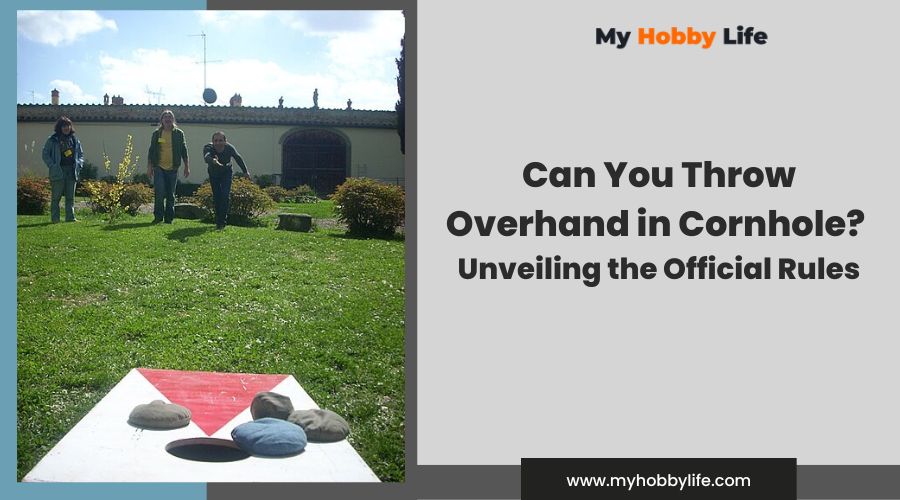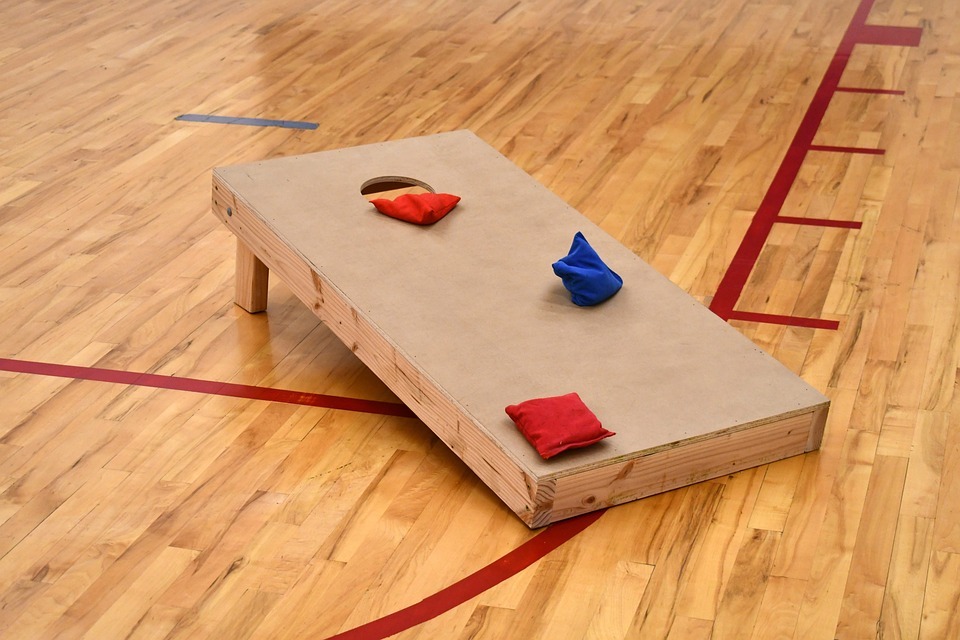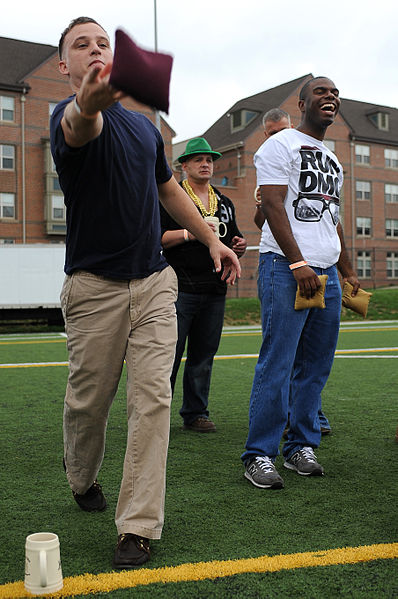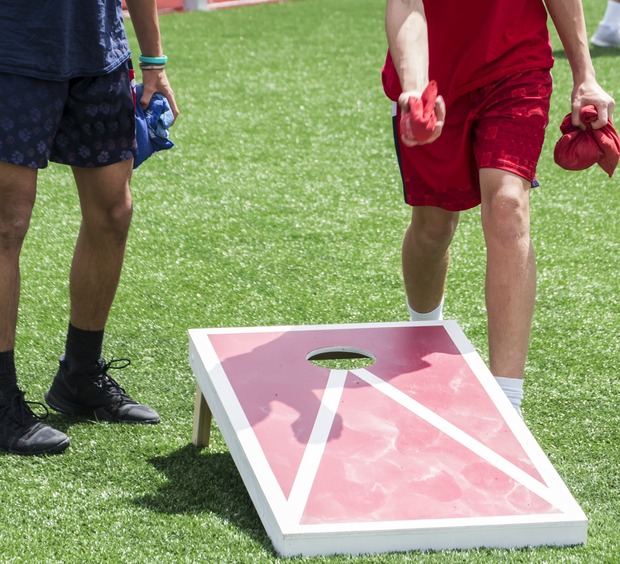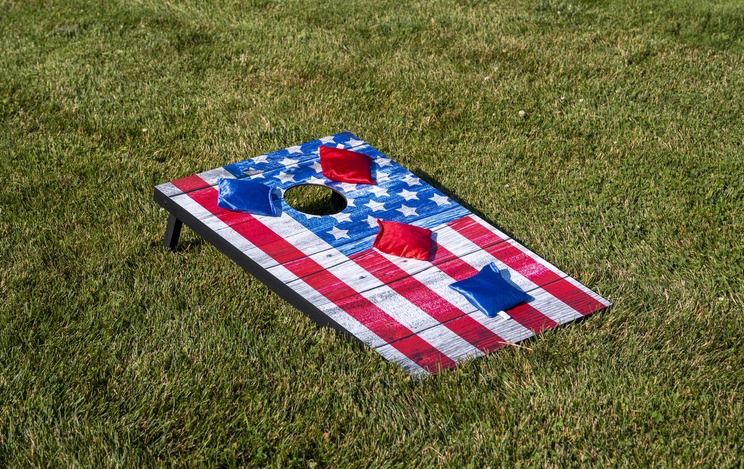Cornhole is a popular lawn game where players take turns throwing bags filled with corn or beans at a raised platform with a hole in the far end. While the underhand toss is traditionally used for its control and ease, players may question whether overhand throws are permitted in the game. The simple answer is yes, players can opt for an overhand throw. However, it’s a less common technique in cornhole due to the precision required when aiming for the board and hole.
An overhand throw might seem appealing to those coming from sports like baseball or softball, where overhand is the standard. It provides a different angle and trajectory that some players might find advantageous. Nevertheless, it’s crucial to remember that the goal of cornhole is to land the bag on the board or in the hole, and mastering the overhand throw might require more practice compared to the traditional underhand toss. The key aspect to consider is whether the use of this technique improves personal gameplay while complying with the standard rules and regulations of cornhole.
Understanding Cornhole
Cornhole is an engaging lawn game popular across various contexts, from casual backyard gatherings to competitive tournaments. This section covers its origins, objectives, necessary equipment, and the nuances of gameplay.
Origins and Popularity
Cornhole, sometimes known as “bag toss,” originated in Germany in the 14th century and was later popularized in Kentucky, USA. Today, cornhole enjoys widespread popularity across the United States and is gaining an international following. The game’s appeal lies in its simple set of rules and the social atmosphere it fosters.
Game Objective
The primary objective in cornhole is to throw cornhole bags—either filled with corn feed or resin—into a hole on the opposing cornhole board. Points are earned for bags in the hole or on the board, with the goal being to reach a score of 21 points before the opponent.
Cornhole Equipment
A standard cornhole set includes:
- 2 cornhole boards: Usually made from wood. They are inclined and each feature a single hole.
- 8 cornhole bags: These bags are 6 inches square and traditionally filled with corn feed, but modern bags may contain resin. The outer material can vary from canvas to twill, suede, or synthetic suede.
Court Layout
The playing area for cornhole consists of two main components:
- Cornhole boards: Placed 27 feet apart from front to front.
- Pitcher’s boxes: Areas to the left and right of each board from where players throw bags. Players must not step past the foul line at the front of their pitching box when making a toss.
Official Rules and Scoring
Official regulations, as set forth by the American Cornhole Association (ACA), state the following:
- Game play: Players take turns throwing bags at the opposite boards.
- Scoring: A bag in the hole scores 3 points, while a bag remaining on the board scores 1 point. This is known as cancellation scoring—if both players score, only the difference in points counts.
- Fouls: A foul bag—tossed out of turn, crossing the foul line, or a bag touching the ground—does not count for points.
For the purest experience and to maintain integrity in competitions, players and officials adhere to these rules closely.
The Basics of Playing Cornhole
Playing cornhole involves a combination of skill and strategy. A proper setup and understanding the techniques and rules of the game are crucial for an enjoyable experience.
Setting Up for Gameplay
To start a cornhole game, players require two cornhole boards placed 27 feet apart from the front edge to front edge. The boards should be positioned on a flat surface with a pitcher’s box designated on both sides. This area is where players stand to toss their bags. During setup, a coin flip usually determines which team throws first.
Cornhole Playing Techniques
When it comes to playing techniques, players have the option of performing an underhand throw or an overhand throw. The underhand toss is most traditional and involves a gentle release with an arc, allowing the bag to land softly on the board. An overhand throw is less common and requires more skill to control the bag’s landing.
Basic Rules and Violations
Every game has its set of rules and cornhole is no different. Players must throw from behind the front of the cornhole board within the pitcher’s box. A foul bag is called for any rule violations such as stepping in front of the line during a toss or a bag touching the ground before landing on the board. Rule violations can result in bags being removed from play.
Scoring Explained
Scoring in cornhole is simple but specific:
- Bag in-the-hole or a “cornhole”: 3 points
- Bag in-the-count or on the board (also called “woody”): 1 point
- Bags touching the ground or hanging off the board: 0 points
Points are calculated at the end of each inning once all bags are thrown.
Determining Winners
The game continues with alternate throwing until one team reaches or exceeds the traditional score of 21 points at the end of any inning. The winning team is determined by who has the higher score after tallying the points in compliance with the cornhole scoring rules.
Advance Play and Strategies
Advancing in cornhole requires understanding both the strategic differences between singles and doubles matches and the refined techniques that can enhance gameplay. Competing in tournaments further demands a deep comprehension of the game’s intricacies. Mastery comes from dedicated practice and learning from each experience.
Single and Doubles Matches
In singles cornhole matches, one player competes against another, allowing for complete focus on personal technique and strategy. Doubles matches, however, introduce collaboration where partners must communicate effectively and adapt their playing styles to synchronize with each other for successful gameplay.
- Singles: Aim for consistency in hold, stance, and pitching; practice creates predictability in throws.
- Doubles: Develop a shared strategy with your partner; alternate shots to maintain a strategic advantage.
Mastering the Game
To master cornhole, devote time to practice various techniques such as the slide, blocker, and push shots. Understanding the conditions, like board texture and weather, and adjusting your strategy accordingly is imperative.
- Techniques: Slide (aiming for the base of the hole), blocker (creating an obstacle for the opponent), push (using your bag to move others).
- Practice: Regularly refine your aim and pitching methods; precise raking can be crucial.
Competitive Play and Tournaments
Competitive play often adheres to regulations set by organizations like the American Cornhole Association (ACA). Familiarize yourself with these rules before participating. Strategy is critical in tournaments, where reading the opponent’s play is as important as executing your own shots.
- ACA: Learn and follow ACA rulesets for standardized play.
- Tournaments: Engage in competitive settings; adaptability to opponents’ techniques is key.
Tips for Improving Your Game
Continuous improvement comes from acknowledging weak points and seeking effective tips to bolster your game.
- Hold: Find a comfortable yet firm grip on the bag.
- Aim: Focus on a consistent aim point near the hole.
- Stance: Ensure a balanced and repeatable stance.
- Pitching: Develop a smooth and controlled pitching movement.
By applying these focused strategies and techniques, players can make significant advances in their cornhole gameplay.
Equipment and Maintenance
Proper care for cornhole equipment ensures longevity and quality of play. Cornhole boards and corn bags are the essential components of the game, and maintaining them correctly is crucial.
Cornhole Boards:
The standard cornhole board dimensions are 2 feet by 4 feet with a 6-inch diameter hole, centered 9 inches from the top. Boards should have a smooth surface, typically made of ½ inch to ¾ inch hardwood plywood. To maintain the board, one should:
- Regularly check the surface for any damage or splinters.
- Clean the surface with a damp cloth to remove dust and debris.
- Apply a quality sealant annually to protect the wood from weathering.
Corn Bags:
Each team has four bags made from durable duck canvas material, filled with approximately two cups of corn kernels or plastic pellets. Here are some maintenance tips for corn bags:
- Store corn bags in a cool, dry place to prevent mold and decay.
- If bags get wet, dry them completely before storage.
- Examine the seams and fabric for any tears and repair them promptly to prevent leakage.
Equipment Standards:
Adhering to equipment standards is vital for fair gameplay:
| Equipment | Standard Specification |
|---|---|
| Board Surface | 2′ x 4′ with a 6″ hole |
| Board Material | ½” to ¾” hardwood plywood |
| Bag Material | Duck canvas |
| Bag Filling | Corn kernels or plastic pellets |
| Bag Weight | 14 to 16 ounces |
For competitive play, it’s important that equipment meets the American Cornhole Organization (ACO) standards. Regularly inspecting equipment and practicing these maintenance steps will ensure a fair and enjoyable cornhole experience.
Playing Cornhole Beyond the Basics
When players move past the fundamentals of cornhole, mastering advanced techniques and strategic thinking becomes key to gaining an upper hand. This section explores these elements in detail, offering insights into taking your game to the next level.
Analyzing Your Opponent’s Strategy
In competitive cornhole, one must be astute in observing an opponent’s strategy. Noting whether they favor an overhand throw or a more traditional underhand toss can inform defensive placement of one’s own bags. Players should assess the advantages and disadvantages of an opponent’s style, adapting their own play to counter effectively.
Advanced Throwing Techniques
There exists a variety of advanced throwing techniques in cornhole, beyond the basic underhand toss. The overhand throw is one such method, though less common, it can offer an unexpected trajectory to the bag. Players should practice multiple techniques, such as the:
- Sling toss
- Frisbee toss
- Overhand toss
- Jump toss
- Fold over toss
Each technique provides different advantages, such as increased spin or altered speed, which can be situational assets.
Enhancing Your Gameplay
Improving at cornhole involves fine-tuning one’s skill set. Players should focus on their grip, often using the thumb for stability and control over the bag. Enhancing gameplay can include practicing different pitches, considering the bag’s filling material, and understanding how the bag reacts upon landing. Consistency in tossing coupled with strategic play typically leads to a more successful cornhole experience.
Cornhole in Different Settings
Cornhole’s adaptability makes it a popular yard game that’s played in various settings from competitive leagues to relaxed backyard gatherings. The key strategies and techniques remain the same; however, the environment may necessitate slight adjustments. For instance:
- In a backyard setting, uneven terrain might affect bag trajectory.
- In a tournament, the atmosphere could induce pressure, affecting a player’s throw.
Each setting requires adaptive strategies while maintaining the fundamental skills of the game.
Cornhole as a Sport
Cornhole, traditionally seen as a backyard game, has gained traction as a competitive sport particularly in the United States. The game’s simplicity and inclusive nature have paved the way for organized play, professional tournaments, and media coverage.
Sport Recognition and Growth
Cornhole’s transformation into an official sport is largely attributed to the formalization by organizations like the American Cornhole Association (ACA). They have been pivotal in standardizing rules and promoting the sport across the country. Growth in the sport is apparent with the increase in competitive leagues and national tournaments that appeal to a diverse range of players.
Joining Cornhole Associations
For enthusiasts looking to transition to professional play, joining an association such as the ACA is a fundamental step. These organizations provide members with the structure needed for competitive play, including:
- Access to sanctioned tournaments
- Official rankings
- Networking opportunities
- Recognition in the sport
This membership is key for those seeking to elevate their game from casual to professional.
Rules for Professional Play
Professional cornhole adheres strictly to official rules and regulations set forth by governing bodies to maintain the integrity of the sport. Key rules include:
- Standard board dimensions: 2-ft. x 4-ft.
- Distance between boards: 27 feet
- Bag dimensions: 6″ x 6″ and a weight of 16 ounces
- Scoring: Reach or exceed 21 points
Players and referees are expected to enforce these regulations during play to ensure fairness and consistency across all tournaments.
Cornhole in the Media
The sport’s visibility has expanded with cornhole in the media. Coverage ranges from online streaming of tournaments to televised championships on sports networks. This exposure has played a vital role in elevating cornhole’s status as an emerging sport and has brought it into the mainstream consciousness. Such media attention has also facilitated sponsorships and professional opportunities for top players.
Frequently Asked Questions
In the game of cornhole, players often have questions regarding official playing techniques, scoring, and specific rules to ensure fair play. Here are answers to some of the most frequently asked questions about the game.
What is the proper way to throw a bag in cornhole?
The accepted method of throwing in cornhole is an underhand toss. The player must release the bag within the pitcher’s box and follow a straight, smooth motion to ensure precision and compliance with official rules.
Are there any penalties for stepping in front of the board during play?
Yes, players must not step over the front edge of the cornhole board when they throw. Doing so can incur a penalty, often resulting in the throw being declared foul and its potential points voided.
Is it allowed to score more than 21 points in a game of cornhole?
The game of cornhole is generally played to exactly 21 points, and the exact rules can vary. Some versions allow overscoring, while others set strict rules that require a player to hit exactly 21 points and not exceed that number.
What are the methods for keeping score in a cornhole match?
Cornhole matches are scored using cancellation scoring, where the points of one team cancel out the points of the other. Points are only awarded for the difference in scores from both teams’ bag placements on the board and in the hole.
What are the specific rules to follow when winning a game of cornhole?
The specific rules for winning a game of cornhole dictate that a player must reach or exceed 21 points. It is crucial for a play to be decisive, finishing the game by maintaining a lead of 2 or more points to avoid ties and continuous play.
Could you explain the ‘bust’ rules in cornhole?
The ‘bust’ rule in cornhole applies when a player exceeds 21 points. In some versions, the player’s score may revert to 13 or another predetermined number, compelling them to work their way back up to 21 without going over again.
